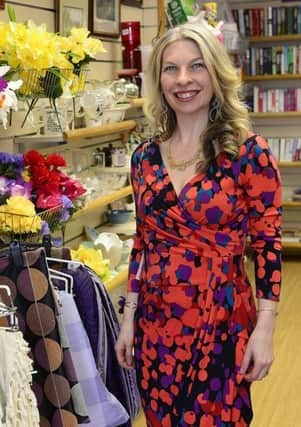First hand experience of second hand shopping


My love affair with second hand shops began when I was an impoverished, but still relatively style-conscious, student.
In those days charity shops were musty, gloomy, moth-eaten places; a hodge-podge of bric-a-brac, polyester nighties and Nana Mouskouri records, frequented mainly by elderly women and the financially embarrassed, like myself.
Advertisement
Hide AdAdvertisement
Hide AdBut despite their appearance (and let’s be honest, their odour) charity shops never failed me during those lean times, for among all the dodgy stone-washed denim and well-worn housecoats, this smug second hand shopper found plenty of gems for her pauper’s purse.
These days, even though I have a few more shekels in my pocket and can afford to hit the high street every so often, in this age of rampant consumerism and throwaway fashion, I still like to buy second hand and welcome the Second Hand September initiative - a drive urging consumers not to buy new clothing for the entire 30 days
The Oxfam-organised campaign aims to raise awareness of fashion’s environmental impact and, in the long-term create new habits, perhaps by swapping clothes, upcycling your own clothes or visiting second hand and charity shops.
It’s certainly never been easier to shop second hand. There are a wealth of online shops selling spruced up preloved items and charity shops have smartened up their image, by getting to grips with visual merchandising, de-cluttering and become brighter places for browsing. Now there are ‘retro rails’ and rare book racks, designer items and colour-blocked rails - even that fusty shop smell isn’t as obvious.
Advertisement
Hide AdAdvertisement
Hide AdAnd the clientele is mixed too. Nowadays you’re as likely to find the well-heeled scouring the rails, as the skint student - because what was once about the aesthetic and the thrill of finding something cool and unusual (although, a large part still is about that), is now about the political and the environmental.
Helen McClements is one of a growing number of people who love clothes but try their hardest to resist buying them for reasons of sustainability.
The Belfast mum-of-two describes herself as an ‘‘incorrigible second hand shopper’’, whose habit, like my own, began when she was a student.
‘‘My friend Maureen, who introduced me to the delights of a charity shop rummage back in 2002,’’ said Helen.
Advertisement
Hide AdAdvertisement
Hide Ad‘‘We were both studying to become English teachers at Queen’s, and the School of Education was happily positioned on the corner of Botanic Avenue. I must confess that we were late for one or two lectures, so busy were we browsing during our lunch hour. We told ourselves that it was important, essential even, to look chic and stylish, so that we could inspire our future students.’’
Sixteen years on, Helen still loves second hand shopping and she has passed on the habit to her children.
‘‘My six and seven year old share a similar inability to pass an Oxfam without nipping in for a quick look. There really ought to be a word for the certain type of delight you feel, when someone admires your outfit and you say, ‘Why thank you, I got the whole lot for £9 and they threw in the beads for free.’’
Over the years Helen has acquired a wardrobe-full of desirable labels.
Advertisement
Hide AdAdvertisement
Hide Ad‘‘I have bought shoes from Dune, dresses from Ted Baker and countless items from Next and Oasis. One icy January I spied a brand new, Alpine worthy down jacket in the Oxfam on Botanic. ‘I hate to tell you,’ said the volunteer at the till, ‘but that coat is £25. It still has the labels on it though.’ Needless to say I snapped it up, and on frosty mornings I could hardly contain my glee as strangers eyed it enviously at the bus stop.’’
Helen explained the reasons why her own love affair with second hand hasn’t diminished.
‘‘In these credit-crunchy times, the best thing about charity shop purchases is that they’re relatively guilt free. It doesn’t matter if I drop a fiver on a skirt and after a few wears decide it’s not for me- I can always wash it and take it back: this allows me to experiment with different styles and be a bit braver with colours I wouldn’t normally wear.
‘‘However, it isn’t just the financial aspect of second-hand shopping which makes it something we should consider more seriously.
Advertisement
Hide AdAdvertisement
Hide Ad“The statistics for the environmental damage caused by the mass production of clothes make for grim reading. According to the World Wildlife Fund, it takes 2,700 litres of water to produce just one cotton tee-shirt. This is water which could have been better employed to nourish a field of crops in the developing world.
“The dyes which are used to create the bold hues we favour in spring time, contain a cocktail of harmful toxins, many of which find their way into fresh-water sources, thus posing a serious health risk to nearby villages and towns.
“So this September, should you be trying to declutter, this is the perfect time to replenish the stock in your local charity shops. Or if like me, your wardrobe needs a revamp, it’s a good opportunity to hurry past the high street and give the second hand stores a whirl instead.
“Your wallet, your conscience, and the environment will be grateful for the swap,’’ she added.